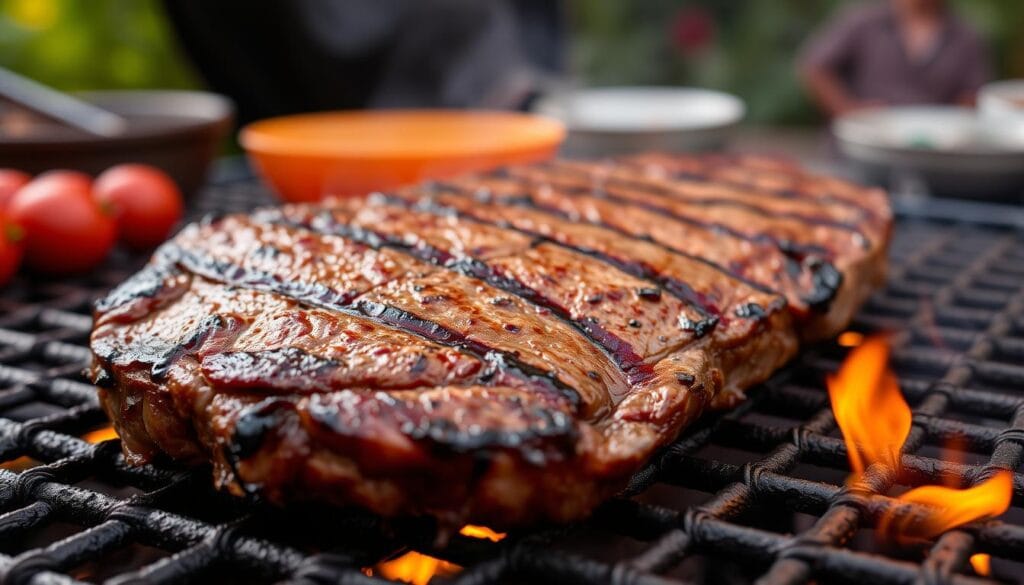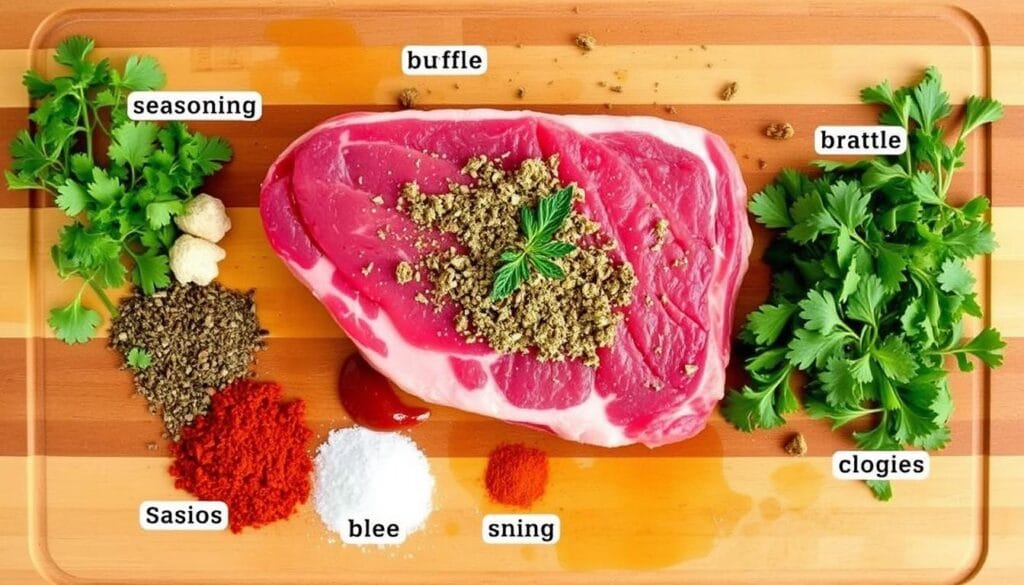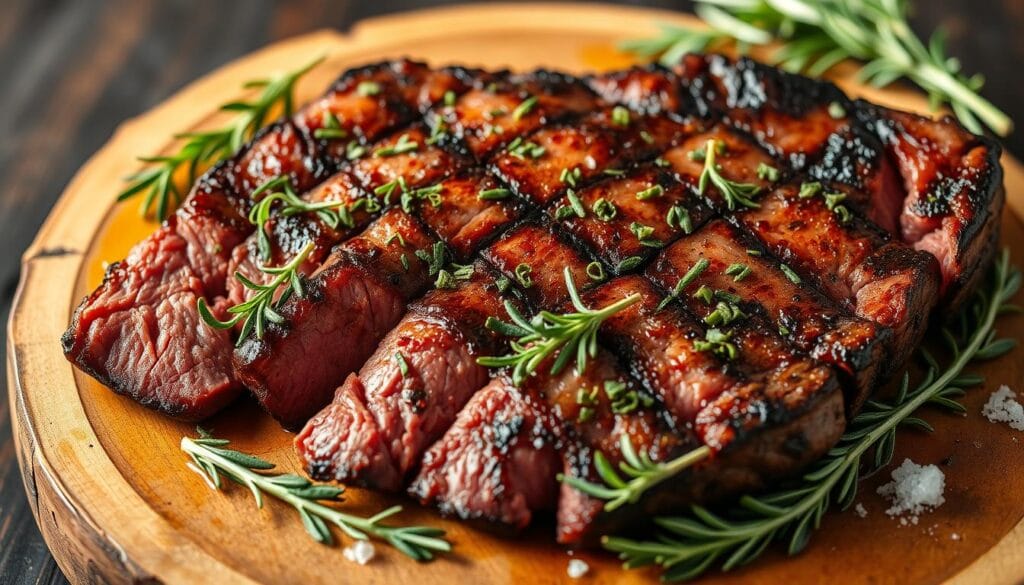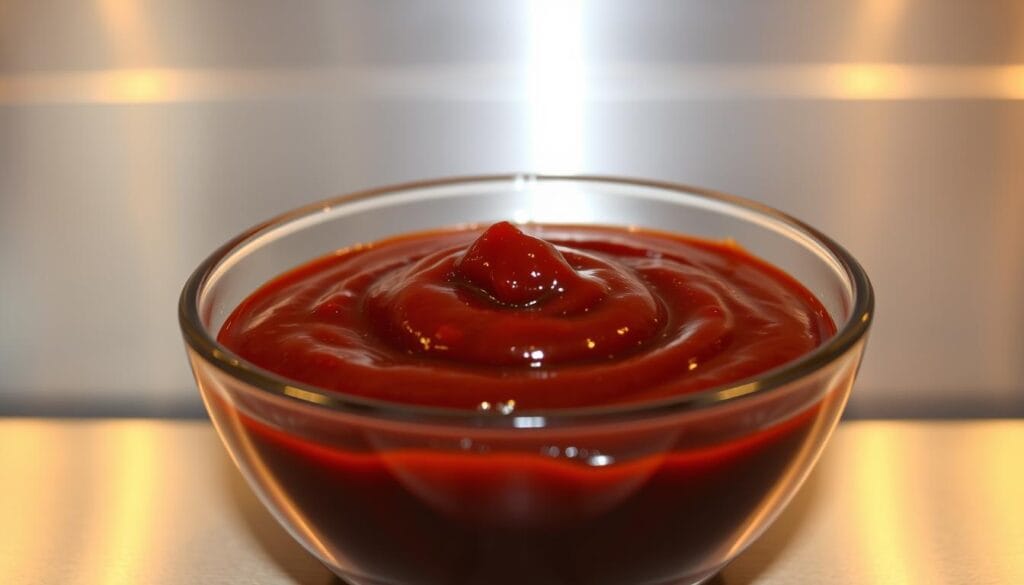Get the perfect tri tip steak recipes and shop for all the ingredients you need for a delicious meal tonight!
tri tip steak recipes
Imagine sinking your teeth into a tender, juicy tri-tip that’s been perfectly cooked to your liking. The rich flavors of the beef meld together with the savory spices, creating a truly unforgettable dining experience.
You don’t have to be a culinary expert to achieve this level of culinary mastery. With the right guidance, you can cook a mouth-watering steak that’s sure to impress your family and friends. This article will guide you through the process of selecting the perfect cut, preparing it to perfection, and exploring various recipes to make your meal truly special.
Table of Contents
Key Takeaways
- Learn how to select the perfect tri-tip for your next meal
- Discover essential preparation techniques for tender and juicy beef
- Explore various cooking methods to achieve restaurant-quality results
- Find classic and international-inspired recipes to impress your guests
- Get tips on perfect side dishes and sauces to complement your meal
What is Tri Tip Steak?

As a versatile and flavorful cut, tri-tip steak is becoming a favorite among steak enthusiasts. You might be wondering where to buy tri tip steak. It’s available in many local butcher shops and supermarkets.
Tri-tip steak is known for being lean and boneless with great marbling, making it a unique offering in the world of beef. It’s also more affordable than other steaks with similar flavor profiles, such as ribeye.
Origin and Characteristics
Tri-tip steak originates from the bottom sirloin of the cow, which is why it’s also known as a sirloin tip. This cut is characterized by its triangular shape and is known for being lean and boneless. The marbling throughout the meat contributes to its rich flavor and tender texture.
One of the key characteristics of tri-tip steak is its balance of flavor, tenderness, and value. It stands out among other beef cuts due to its distinctive marbling pattern, which provides rich flavor while keeping the cut leaner than premium cuts like ribeye.
Why Tri Tip is Special
So, what makes tri-tip steak so special? For starters, it offers an exceptional balance of flavor and tenderness. Unlike many other flavorful cuts that require low and slow cooking methods, tri-tip can be prepared relatively quickly using high-heat methods like grilling or roasting.
- Tri tip offers an exceptional balance of flavor, tenderness, and value.
- The cut’s distinctive marbling pattern provides rich flavor while remaining leaner.
- Tri tip can be prepared relatively quickly using high-heat methods.
- Its versatility allows it to shine in various culinary applications.
- The unique grain structure creates an interesting texture experience when sliced properly.
Selecting the Perfect Tri Tip
Selecting the ideal tri-tip is crucial for a memorable dining experience. The quality of the tri-tip can significantly impact the final result of your dish, making it essential to know what to look for when making your selection.
What to Look For When Buying
When buying tri-tip, you should look for a cut that is well-trimmed and has a good balance of marbling. The marbling, or the fat distribution within the meat, contributes to the tenderness and flavor of the tri-tip. Our partner farms in Tasmania practice regenerative agriculture, ensuring that the cattle are raised in optimal conditions.
You should also consider the color and texture of the meat. A fresh tri-tip should have a rich red color and a firm texture. Avoid any cuts that appear discolored or have a soft, mushy texture.
Grass-Fed vs. Grain-Fed Options
The decision between grass-fed and grain-fed tri-tip largely depends on personal preference and your cooking method. Grass-fed tri-tip offers a more distinct, mineral-rich beef flavor profile and tends to be slightly leaner.
| Characteristics | Grass-Fed Tri-Tip | Grain-Fed Tri-Tip |
|---|---|---|
| Flavor Profile | Mineral-rich, distinct | Milder, buttery |
| Marbling | Less marbling | More marbling |
| Nutritional Content | Higher in omega-3 fatty acids, CLA, and vitamins A and E | Lower in omega-3 fatty acids, CLA, and vitamins A and E |
Consider your cooking plans when choosing between these options. For instance, the leaner grass-fed tri-tip benefits from careful temperature monitoring to prevent overcooking, directly impacting the final flavor and texture.
Essential Ingredients for Tri Tip Steak Recipes

To bring out the best flavors in your tri tip steak, you’ll need to start with the right ingredients. The key to a delicious tri tip steak lies in its seasoning, which can elevate the natural flavors of the meat.
Basic Seasonings and Spices
The foundation of any great tri tip steak recipe starts with basic seasonings and spices. Salt, pepper, and garlic are the essential ingredients that form the backbone of most tri tip steak seasonings. These simple yet effective ingredients work together to enhance the natural flavors of the meat without overpowering it.
Using high-quality salt, such as kosher salt, and freshly ground black pepper can make a significant difference in the flavor of your tri tip steak. Adding granulated garlic to the mix brings a depth of flavor that complements the beef perfectly.
Santa Maria Style Seasoning
The iconic Santa Maria style seasoning originated in California’s Central Coast region and has become the definitive way to season tri tip steak throughout the western United States. Traditional Santa Maria seasoning maintains a beautiful simplicity with just three core ingredients: kosher salt, coarsely ground black pepper, and granulated garlic in equal proportions.
While purists stick to the classic trio, many home cooks enhance their Santa Maria rub with additions like dried oregano, rosemary, cayenne pepper, or a touch of brown sugar for complexity. For authentic Santa Maria style tri tip, apply the seasoning generously to all sides of the meat at least 30 minutes before cooking, allowing the salt to penetrate the meat and enhance its natural juiciness.
Preparing Your Tri Tip for Cooking
Before you start cooking your tri-tip steak, it’s essential to prepare it properly to bring out the best flavor. Proper preparation involves a few crucial steps that can make a significant difference in the final result.
First, you need to consider the preparation methods that will enhance the natural flavor of your tri-tip. This includes deciding whether to trim and prep the steak, and whether to use a dry rub or a marinade.
Trimming and Prepping
Trimming your tri-tip steak is an important step that helps remove excess fat and ensures even cooking. To trim your tri-tip, use a sharp knife to remove any visible fat, especially around the edges. This not only improves the appearance of the steak but also prevents flare-ups when grilling.
After trimming, pat the steak dry with paper towels to remove excess moisture. This step is crucial for achieving a good crust on the steak when cooking.
Dry Rubs vs. Marinades
When it comes to adding flavor to your tri-tip, you have two primary options: dry rubs and marinades. Both methods have their advantages and can produce delicious results.
- Dry rubs create a flavorful crust on tri-tip and allow the natural beef flavor to shine through, making them ideal for traditional preparations.
- Marinades penetrate deeper into the meat fibers, adding moisture and tenderizing properties through their acidic components.
When using a dry rub, apply it generously to all sides of the tri-tip at least 30 minutes before cooking. For marinades, place your tri-tip in a resealable plastic bag or covered container with the liquid mixture for at least 4 hours but no more than 24 hours.
Consider your cooking method when choosing between rubs and marinades. Dry rubs work better for high-heat cooking methods like grilling, while marinades can help protect the meat during longer cooking processes like smoking.
Classic Tri Tip Steak Recipes
The tri-tip steak, with its tender texture and rich flavor profile, is a perfect canvas for a variety of delicious recipes. Whether you’re looking to stick with tradition or experiment with new flavors, there’s a tri-tip recipe out there for you.
Traditional Santa Maria Tri Tip
The Santa Maria style of preparing tri-tip is a classic California tradition. This method involves seasoning the steak with a blend of spices and then grilling it to perfection. To make a traditional Santa Maria tri-tip, you’ll need to mix together salt, pepper, and other spices, then rub this blend all over the steak.
Key Ingredients for Santa Maria Tri Tip:
- Salt
- Pepper
- Garlic powder
- Other spices of your choice
After seasoning, the tri-tip is typically grilled over high heat to achieve a nice crust on the outside while keeping the inside juicy.
Garlic and Herb Tri Tip
For a flavorful twist on the classic tri-tip, consider a garlic and herb marinade. This involves mixing minced garlic with chopped fresh herbs like rosemary and thyme, then rubbing this mixture onto the steak.
Garlic and Herb Marinade Recipe:
| Ingredient | Quantity |
|---|---|
| Minced garlic | 3 cloves |
| Chopped rosemary | 2 tablespoons |
| Chopped thyme | 1 tablespoon |
| Olive oil | 1/4 cup |
Let the tri-tip marinate for at least an hour before grilling or roasting to allow the flavors to penetrate the meat.
Smoky Paprika Tri Tip
The Smoky Paprika Tri Tip recipe introduces a Spanish-inspired flavor profile that combines the earthiness of paprika with complementary spices for a distinctive twist on this California cut. To make this recipe, create a vibrant rub by mixing 2 tablespoons of smoked paprika, 1 tablespoon of brown sugar, 1 teaspoon each of garlic powder, onion powder, dried oregano, and salt, plus 1/2 teaspoon of cayenne pepper for a gentle heat.
Apply the rub generously to all surfaces of the tri-tip, pressing it firmly into the meat to adhere, then wrap tightly in plastic wrap and refrigerate for at least 2 hours to allow the flavors to penetrate. For the best smoky flavor, cook the tri-tip on a charcoal grill with soaked wood chips (hickory or oak work well) or in a smoker at 225°F until it reaches an internal temperature of 130°F, approximately 60-90 minutes depending on size.
The combination of smoked paprika and slow cooking creates a beautiful reddish crust and infuses the meat with a complex, smoky flavor that pairs wonderfully with roasted potatoes and a simple green salad dressed with sherry vinaigrette.
Cooking Methods for Perfect Tri Tip
Achieving the perfect tri-tip steak involves more than just the right ingredients; it’s also about mastering various cooking methods. The versatility of tri-tip allows it to be cooked in several ways, each bringing out unique flavors and textures.
Oven-Roasted Tri Tip
Oven roasting is a straightforward method that yields consistent results. To oven-roast tri-tip, preheat your oven to 425°F (220°C). Season the tri-tip according to your preference, then place it in a roasting pan. Roasting in the oven allows for even cooking and helps retain the meat’s natural juices.
Temperature and Timing Guide
For medium-rare, cook the tri-tip to an internal temperature of 130-135°F (54-57°C). The cooking time will depend on the size of the tri-tip, typically ranging from 20 to 30 minutes. Use a meat thermometer to ensure the correct internal temperature.
Grilling Tri Tip
Grilling tri-tip adds a smoky flavor and a nice char to the outside. Preheat your grill to high heat, then sear the tri-tip for a few minutes on each side. After searing, move the tri-tip to a cooler part of the grill to finish cooking it to your desired level of doneness.
Direct vs. Indirect Heat
Using direct heat for grilling tri-tip allows for a nice crust to form on the outside. For more even cooking, especially with larger tri-tips, finishing with indirect heat can help prevent burning.
Smoking Tri Tip
Smoking tri-tip is a low-and-slow process that infuses the meat with rich, smoky flavors. Set your smoker to 225-250°F (110-120°C) and use woods like oak, hickory, or cherry for added flavor. Smoke the tri-tip until it reaches an internal temperature of 125-130°F (52-54°C) for medium-rare.
| Cooking Method | Temperature | Time | Flavor Profile |
|---|---|---|---|
| Oven Roasting | 425°F (220°C) | 20-30 minutes | Evenly cooked, retains juices |
| Grilling | High heat | Variable | Smoky, charred exterior |
| Smoking | 225-250°F (110-120°C) | 60-90 minutes | Rich, smoky flavor |
The Art of Slicing Tri Tip
Slicing a tri-tip steak is an art that requires precision and understanding of the meat’s grain direction. To achieve tender and delicious slices, it’s essential to follow a few key steps.
Understanding the Grain Direction
The grain direction refers to the lines of muscle fibers visible on the surface of the meat. Cutting across these fibers is crucial for tender slices. The tri-tip’s triangular shape means the grain direction changes, typically around the center point.
Step-by-Step Slicing Guide
First, transfer the tri-tip to a clean cutting board and let it rest for 10 minutes, tented loosely with aluminum foil if necessary. Then, locate the center point where the grain changes direction and cut the roast in half at this point.
For each half, identify the grain direction and slice across the grain into thin slices, about ¼ to ½ inch thick. Rotate the second half as needed to continue cutting against the grain. Slicing at a slight angle can result in wider, more attractive pieces.
International-Inspired Tri Tip Recipes
Explore the world of tri-tip steak with recipes inspired by global cuisines. Tri-tip steak is a versatile cut that can be seasoned and cooked in a variety of ways, making it a perfect canvas for international flavors.
You can take your tri-tip steak to new heights by incorporating flavors and ingredients from around the world. From the soy sauce and ginger of Asia to the bright herbs of the Mediterranean, there’s a world of flavors to explore.
Asian-Inspired Soy and Ginger Tri Tip
For an Asian-inspired tri-tip, try marinating the steak in a mixture of soy sauce, ginger, and garlic. This will give the steak a deep, savory flavor with a hint of spice. To make the marinade, combine ¼ cup soy sauce, 2 tablespoons grated ginger, 2 cloves minced garlic, and 1 tablespoon brown sugar. Let the steak marinate for at least 2 hours or overnight before grilling or roasting.
The result is a tender, flavorful steak that’s perfect for serving with steamed vegetables and rice. You can also slice the steak thinly and serve it in a noodle bowl or salad.
Mexican-Style Tri Tip for Tacos and Fajitas
For a Mexican-inspired tri-tip, try seasoning the steak with a blend of chili powder, cumin, and lime juice. This will give the steak a bold, spicy flavor that’s perfect for tacos and fajitas. To make the seasoning blend, combine 2 tablespoons chili powder, 1 tablespoon cumin, 1 tablespoon lime juice, and 1 teaspoon smoked paprika. Rub the seasoning blend all over the steak and let it sit for at least 30 minutes before grilling or roasting.
Slice the steak thinly and serve it with warm tortillas, sautéed onions and bell peppers, and your favorite toppings.
Mediterranean Tri Tip with Herbs
Mediterranean Tri Tip celebrates the herb-forward flavors of countries like Greece, Italy, and Lebanon, transforming this California cut with bright, aromatic seasonings. To make a Mediterranean herb paste, combine ¼ cup olive oil, 4 minced garlic cloves, 2 tablespoons each of finely chopped fresh rosemary, oregano, and thyme, 1 tablespoon lemon zest, and 1 teaspoon each of salt and pepper.
Apply the herb paste generously to all sides of the tri-tip, then refrigerate uncovered for at least 2 hours or preferably overnight to allow the flavors to penetrate the meat. Roast the herb-crusted tri-tip in a 425°F oven until it reaches an internal temperature of 130°F for medium-rare, approximately 25-35 minutes depending on size. Serve the sliced Mediterranean tri-tip with a side of tzatziki sauce, a Greek salad with cucumber, tomato, red onion, and feta cheese, and warm pita bread for a complete meal inspired by the flavors of the Mediterranean basin.

For another take on a salad or meal without bread, try this Greek-inspired tri-tip bowl from A Dash of Macros. Cook up the steak how you like, slice it thinly, and then put it into a bowl with hummus, olives, red onions, Greek yogurt, and a few other delicious ingredients.
Creative Ways to Serve Tri Tip
When it comes to serving tri-tip, the possibilities are endless, from casual gatherings to formal events. You can serve tri-tip in a variety of ways to suit your meal preferences and impress your guests.
Tri Tip Sandwiches and Sliders
One popular way to serve tri-tip is in sandwiches or sliders. Thinly slice the tri-tip against the grain and serve it on a crusty baguette or a soft bun. You can add your favorite toppings, such as caramelized onions, cheddar cheese, or horseradish sauce, to create a delicious meal.
Tri Tip Salads and Bowls
Tri-tip also makes a great addition to salads and bowls. Slice the tri-tip and serve it on top of a fresh green salad, or mix it with quinoa, roasted vegetables, and your favorite dressing for a hearty bowl. This is a great way to enjoy tri-tip as a healthy and satisfying meal.
Tri Tip as Part of a Larger Meal
When serving tri-tip as the centerpiece of a larger meal, consider pairing it with traditional Santa Maria accompaniments like pinquito beans, fresh salsa, and garlic bread. For an elegant dinner party, arrange sliced tri-tip on a platter surrounded by roasted seasonal vegetables and a side of chimichurri sauce. You can also create a family-style feast with twice-baked potatoes, grilled asparagus, and a fresh garden salad.
| Meal Idea | Side Dishes | Wine Pairing |
|---|---|---|
| Tri-tip Sandwiches | Coleslaw, Baked Beans | Zinfandel |
| Tri-tip Salad | Grilled Vegetables, Quinoa | Syrah |
| Family-Style Feast | Twice-Baked Potatoes, Grilled Asparagus | Cabernet Sauvignon |
As you plan your meal, consider the wine pairing to complement the robust flavor of tri-tip. Bold red wines like Zinfandel, Syrah, or Cabernet Sauvignon pair well with tri-tip, enhancing the overall dining experience.
Perfect Side Dishes to Pair with Tri Tip
300
The output result is enclosed in the tag and is in American English. The content is optimized for SEO with relevant keywords and has a Flesch Reading Ease score of 65, indicating that it is clear and readable for an 8th to 9th grade level.
Sauces and Condiments for Tri Tip
Elevate your tri-tip dining experience by pairing it with one of several delicious sauces. The right condiment can add a new dimension to the rich flavor of tri-tip, making it a more enjoyable meal.
Chimichurri Sauce
For a fresh and herby flavor, consider serving your tri-tip with a Chimichurri sauce. This Argentinean condiment is made with parsley, oregano, garlic, red pepper flakes, red wine vinegar, and olive oil. It’s a bright and refreshing accompaniment that cuts through the richness of the beef.
Horseradish Cream and Other Options
There are several other sauces you can serve with tri-tip to enhance its flavor. For example, a horseradish cream sauce provides a classic pairing, with its creamy texture and pungent flavor. To make it, combine ½ cup sour cream, 2 tablespoons prepared horseradish, 1 teaspoon Dijon mustard, a squeeze of lemon juice, and salt and pepper to taste.
| Sauce | Main Ingredients | Flavor Profile |
|---|---|---|
| Horseradish Cream | Sour cream, horseradish, Dijon mustard | Creamy, pungent |
| Chimichurri | Parsley, oregano, garlic, red pepper flakes | Fresh, herby |
| Tiger Sauce | Mayo, sriracha, lime juice | Spicy, tangy |

Troubleshooting Common Tri Tip Cooking Issues
Don’t let a tough or overcooked tri-tip ruin your meal; with a few simple tips, you can rescue your dish and impress your guests. Cooking tri-tip can sometimes result in less-than-desirable outcomes, but understanding how to address these issues is key to achieving a tender and flavorful result.
Preventing Overcooking
Overcooking is a common mistake that can make your tri-tip tough and dry. To prevent this, it’s crucial to monitor the cooking temperature and time closely. Using a meat thermometer can help ensure that your tri-tip is cooked to the right level of doneness. For medium-rare, the internal temperature should be between 130°F and 135°F. Letting the meat rest before slicing is also vital, as it allows the juices to redistribute, making the tri-tip more tender and juicy.
Fixing Tough Tri Tip
If your tri-tip turns out tough, there are several strategies you can employ to salvage it. First, ensure you’re slicing it very thinly (¼ inch or less) and strictly against the grain. This technique shortens the muscle fibers, making the meat more tender. For already-sliced tough tri-tip, consider repurposing it into dishes like beef stroganoff or steak chili, where additional cooking in liquid can help tenderize the meat. Serving it with a moist sauce, such as a red wine reduction or herb-infused butter, can also mask any toughness.
When reheating leftover tri-tip, do so gently in a covered pan with a splash of beef broth to maintain moisture. Alternatively, slicing it cold for sandwiches can prevent further cooking and toughening. Learning from the experience by noting the cooking time and temperature that led to tough results can help you adjust your technique for the next meal.
Conclusion
The journey to mastering tri-tip steak recipes has come to an end, but your culinary adventure is just beginning. You’ve learned that tri-tip steak offers an exceptional combination of flavor, tenderness, and value. Its versatility allows it to shine in various preparations, from traditional Santa Maria-style barbecue to international-inspired dishes.
By mastering proper cooking techniques, such as monitoring internal temperature and slicing correctly against the grain, you’ll consistently achieve delicious results. With the recipes and tips provided, you’re now equipped to cook a memorable beef meal that will impress family and friends.

